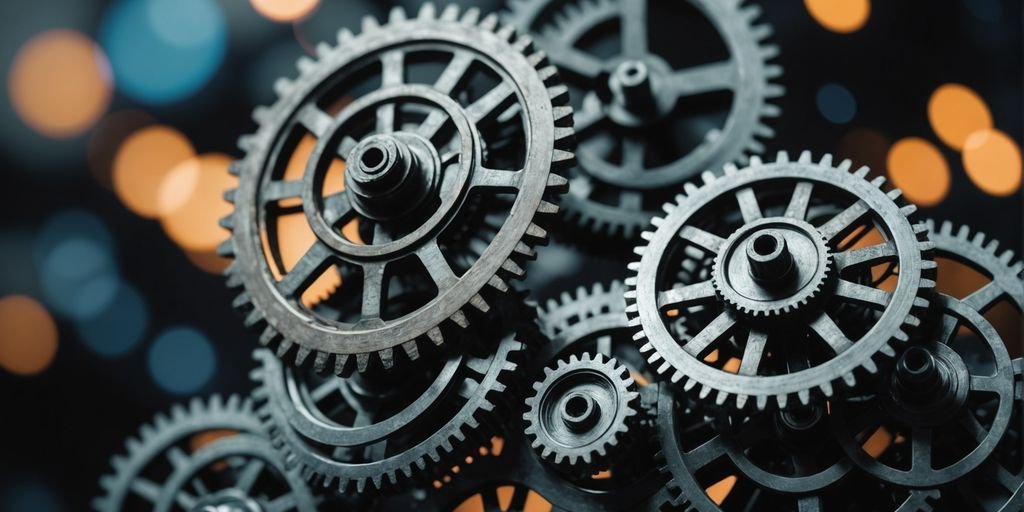The technological landscape is continuously evolving, and Artificial Intelligence (AI) is at the forefront of this transformation. One of the most impactful applications of AI is in predictive maintenance software, which is revolutionizing how businesses manage their equipment and infrastructure. By leveraging the latest trends in AI, companies can predict potential failures before they occur, ensuring uninterrupted operations and optimizing the lifespan of their assets. This article delves into how AI is scaling new heights in predictive maintenance and the associated trends that are shaping the future of this technology.
Key Takeaways
- AI-driven predictive maintenance is increasingly being integrated into energy infrastructure, utilizing machine learning to analyze data from sensors and IoT devices, which leads to reduced downtime and improved reliability.
- In the realm of cybersecurity and software development, AI is enhancing proactive measures and automating testing processes, thereby improving the resilience and reliability of IT systems.
- Staying informed about the latest AI developments, including advancements in NLP, ethical considerations, and applications in climate change solutions, is crucial for businesses to maintain a competitive edge and ensure responsible innovation.
Harnessing AI for Predictive Maintenance in Energy Infrastructure
The Rise of AI-Driven Predictive Maintenance
The integration of AI in predictive maintenance is revolutionizing the energy sector. By leveraging machine learning algorithms, energy companies are now able to anticipate equipment failures with remarkable accuracy. This not only ensures a higher degree of operational efficiency but also significantly reduces unplanned downtime.
- Predictive analytics are being used to monitor the health of equipment in real-time, utilizing data from sensors and IoT devices.
- AI-driven tools are enhancing service reliability, fostering sustainable energy consumption, and supporting the energy market’s predictive capabilities.
The democratization of AI is making these advanced predictive maintenance technologies more accessible to a wider range of companies, allowing for a broader adoption across the energy industry.
The recent trend towards generative AI in the energy sector underscores the technology’s potential to compensate for talent shortages and facilitate more efficient resource allocation. As AI continues to evolve, its role in predictive maintenance is expected to grow, further embedding itself as a critical component in the maintenance strategies of energy infrastructures.
Implementing Machine Learning for Equipment Failure Predictions
The integration of machine learning (ML) into predictive maintenance represents a significant leap forward in industrial efficiency. Machine learning models are now essential tools for analyzing data from sensors and IoT devices, providing actionable insights that lead to reduced downtime and improved equipment reliability. These models are trained on historical data, enabling them to identify patterns and anomalies that may indicate impending equipment failure.
In the realm of energy infrastructure, predictive maintenance software is increasingly leveraging AI to anticipate and prevent equipment malfunctions before they occur. This proactive approach is not only about preventing failure but also about optimizing maintenance schedules to ensure the highest levels of operational efficiency. For instance, the "Predix" platform utilizes machine learning algorithms to enhance maintenance strategies and minimize unplanned disruptions.
The strategic implementation of AI in predictive maintenance is transforming how energy companies manage their assets, leading to a new era in industrial efficiency.
Here are some key benefits of implementing ML for equipment failure predictions:
- Early detection of potential issues, allowing for timely intervention
- Optimization of maintenance schedules to avoid unnecessary downtime
- Significant cost savings by preventing catastrophic equipment failures
- Enhanced decision-making through automated reporting and data visualization
It’s crucial for organizations to stay informed about the latest AI developments and to consult with data solutions providers for the most effective predictive insights.
Consulting Data Solutions Providers for Enhanced Predictive Insights
In the rapidly evolving field of predictive maintenance, consulting with data solutions providers has become a cornerstone for achieving cutting-edge performance and reliability. Leading innovators in predictive maintenance systems are continuously refining their offerings to meet the complex demands of modern infrastructure. Among these, companies like Siemens, General Electric, ABB, and Honeywell stand out for their contributions to sectors such as oil and gas, where precision and uptime are paramount.
The landscape of predictive maintenance software is also witnessing significant growth, with platforms like Fiix CMMS, Limble, and Oracle Service Monitoring for Connected Assets Cloud gaining traction. Here’s a snapshot of the top software in this domain:
| Rank | Software Name |
|---|---|
| 1 | Fiix CMMS |
| 2 | Limble |
| 3 | Oracle Service Monitoring for Connected Assets Cloud |
By leveraging the expertise of these data solutions providers, businesses can harness AI to not only predict equipment failures but also to optimize maintenance schedules, reduce downtime, and ultimately save on costs.
The integration of AI into predictive maintenance is not just about anticipating equipment failures; it’s also about fostering a culture of continuous improvement and strategic decision-making. AI-driven analytics and machine learning models are instrumental in enabling automated reporting, identifying bottlenecks, and streamlining processes for enhanced operational efficiency.
AI’s Role in Cybersecurity and Software Development Lifecycle
Predictive Analysis for Proactive Cybersecurity Measures
In the ever-evolving landscape of cybersecurity, predictive analysis stands as a beacon of hope for organizations seeking to fortify their digital defenses. The recent trend in cybersecurity analytics, particularly in the realm of predictive analytics, has shown a significant shift towards AI-driven solutions. These advanced systems are designed to analyze patterns from past cyber incidents and current network behaviors to predict and prevent future attacks, ensuring a more resilient security posture.
The integration of AI in cybersecurity is not just about defense but about adopting a proactive stance. By analyzing vast datasets, AI algorithms can detect subtle anomalies and indicators of compromise that would otherwise go unnoticed.
The following are some key predictions for AI’s role in cybersecurity:
- Enhanced Threat Intelligence: AI solutions will provide more nuanced threat intelligence, detecting unseen patterns and anomalies.
- Real-time Network Traffic Analysis: AI-based systems will offer real-time analysis, preempting potential threats and safeguarding data.
- Automated Responses: Upon detection of threats, AI will trigger automated responses, reducing response times and mitigating the impact of breaches.
As we look to the future, it’s clear that AI developments will continue to shape the user experience in cybersecurity, integrating adaptive measures that are both proactive and predictive.
Automating Software Testing with AI for Improved Reliability
The integration of AI into software testing is revolutionizing the way developers ensure the quality and reliability of their applications. AI-driven tools are not only automating tests but also generating and reviewing code, leading to a significant acceleration in development cycles and an enhancement in code quality. This trend is particularly relevant in the context of Agile and Continuous Delivery, where speed and efficiency are paramount.
The scope of AI in automation testing is vast, encompassing predictive analysis for proactive problem-solving, user experience optimization, and the validation of software across various environments.
In the realm of cybersecurity, AI’s predictive capabilities are being harnessed to fortify security protocols. By anticipating potential threats, AI is transforming DevSecOps with a proactive approach to security, rather than a reactive one. This is crucial in an era where cyber threats are becoming increasingly sophisticated.
Here are some key areas where AI is making an impact in automating software testing:
- Automated Code and Test Generation: AI tools can generate test cases and code snippets, streamlining the development process.
- Predictive Analysis: Identifying potential issues early in the software development lifecycle.
- Enhanced User Experience: Leveraging user behavior data to inform UI/UX improvements.
- Security Enhancement: Integrating AI to predict and mitigate potential security threats.
Staying Ahead: Understanding AI Developments and Ethical Considerations
In the rapidly evolving field of AI, staying informed about the latest trends and ethical considerations is paramount. The integration of AI into cybersecurity has been a significant trend, with the emergence of generative AI marking a new era in predictive capabilities. This ‘third wave’ of AI not only automates repetitive tasks but also plays a crucial role in reducing human error, thereby enhancing security measures.
As AI systems become more advanced, the ethical implications grow more complex. It is essential to foster an AI-ready culture that prioritizes continuous learning and adaptability, ensuring that AI developments align with societal values and ethical standards. Implementing ethical AI guidelines that focus on transparency, accountability, and fairness is not just a regulatory requirement but a moral imperative.
The future of AI in cybersecurity and beyond hinges on our ability to navigate the intersection of technological advancement and ethical practice. As we anticipate further developments in AI, from healthcare expansion to advancements in natural language processing (NLP), the conversation around ethics becomes increasingly critical.
To stay ahead, industry leaders and policymakers must collaborate to ensure that AI is used in a manner that benefits all, making ethics a priority in every AI initiative. This includes adhering to compliance and regulatory issues, and ensuring AI systems are unbiased, secure, and in line with ethical guidelines.
Conclusion
As we have explored throughout this article, AI’s role in predictive maintenance software is scaling new heights, offering transformative solutions across various industries. From enhancing cybersecurity resilience to optimizing IT infrastructure maintenance, AI-driven tools are becoming indispensable for proactive problem-solving and ensuring system reliability. The integration of AI in areas such as climate change solutions and eco-monitoring further underscores its potential to address some of the most pressing global challenges. For businesses looking to stay competitive and innovative, keeping abreast of AI developments and strategically incorporating them into operations is not just beneficial but essential. The future of maintenance and monitoring is undeniably intertwined with AI advancements, and embracing these technologies will be pivotal for driving efficiency, sustainability, and success in the years to come.
Frequently Asked Questions
How can AI-driven predictive maintenance improve energy infrastructure?
AI-driven predictive maintenance uses machine learning models to analyze data from sensors and IoT devices, predicting equipment failures before they happen. This reduces downtime, improves reliability, and optimizes performance, resulting in enhanced service reliability and cost savings for energy infrastructure.
What are the benefits of using AI for cybersecurity in software development?
AI in cybersecurity helps predict potential threats and vulnerabilities proactively, allowing for preemptive measures to secure software. Automated testing with AI improves software reliability by validating integrity and performance, and predictive analysis optimizes development workflows, enhancing overall software quality.
Why is it important to stay updated on AI developments and trends?
Staying updated on AI developments and trends is crucial as it enables businesses and individuals to leverage the latest advancements, such as NLP improvements, AI-driven cybersecurity solutions, and AI applications in healthcare. It also helps address growing ethical concerns and ensures that AI integration aligns with current and future needs.



